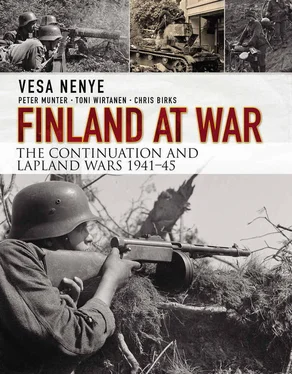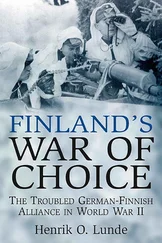Reichsführer-SS Heinrich Himmler visits Finland.
30 July
Stalin issues Order No. 227: ‘Not a step back.’
2 August
Mannerheim agrees to participate in the attack on Sorokka (Belomorsk), provided that German forces take Leningrad by September.
23 August
The German vanguard advances to Stalingrad.
13 September
The German attack at Stalingrad begins.
9 October
Hitler permanently abandons plans to capture Leningrad.
22 October
In Stockholm, junior diplomatic official (and NKVD secret agent) Boris Yartsev hints at the possibility of peace between Finland and the Soviet Union.
3 November
The Cabinet of Finland forbids the mass deportation of Jewish refugees.
16 December
Soviet troops break through Italian lines on the Don front.
22 December
Soviet forces attack in the Caucasus.
2 January
German forces begin their retreat from the Caucasus.
31 January
Commander of Sixth Army Friedrich Paulus is captured at Stalingrad.
1 February
The Finnish Air Force agrees a deal with Germany for the delivery of 30 modern Messerschmitt Bf 109 G-2 fighters.
2 February
Axis forces surrender at Stalingrad.
21 February
German forces counter-attack at Kharkov.
4 March
Mannerheim informs Germany that he will cease offensive operations.
13 March
Hitler prioritises the offensive on the Kursk front. The troops expected to be freed up after this are to be redeployed as part of Operation Parkplatz , the capture of Leningrad.
15 March
German forces retake Kharkov.
20 March
The United States offers Finland its services in opening up dialogue with the Soviet Union.
26 March
Ribbentrop chides Finland for its intentions of peace.
17 April
Lieutenant-General Talvela requests that Mannerheim let him return from Germany to a front-line command. ‘Om det blir krig’ (‘If the war starts’), promises Mannerheim.
23 April
The American chargé d’affaires receives instructions on severing diplomatic ties with Finland.
25 April
The United States cancels the breaking of diplomatic ties.
12 May
Axis forces in North Africa surrender.
22 May
The Soviet Union dissolves the Comintern.
1 June
The Finnish Volunteer Battalion of the Waffen-SS returns to Hanko for a period of leave.
2 June
The Western Allies inform the Soviet Union that the invasion of Europe will be postponed until spring 1944.
27 June
Mannerheim informs Hitler that Finland needs the men of the Finnish Volunteer Battalion of the Waffen-SS for itself and that these troops will not return to Germany.
10 July
The Allies land in Sicily.
11 July
The Finnish Volunteer Battalion of the Waffen-SS is disbanded.
30 July
The Soviet Union enquires about the Finnish view on peace terms.
3 August
The Finns decide to respond to Soviet peace enquiries.
11 August
The Soviet Union rejects Finnish peace proposals.
13 October
Italy declares war on Germany.
14–15 October
General Jodl visits Finland and informs Mannerheim of Germany’s military situation.
6 November
Soviet troops take Kiev.
18 November
Mannerheim orders the construction of the Viipuri–Kuparsaari–Taipale (VKT) Line on the Karelian Isthmus, and the U Line north of Ladoga.
20 November
The Soviet ambassador to Sweden, Alexandra Kollontai, proclaims that Finland will not be required to surrender unconditionally.
26 November
Ribbentrop enquires about the possibility of a political union between Finland and Germany.
29 November
The Finns inform Kollontai that they are ready to negotiate based on the borders of 1939.
28 November–1 December
Stalin, Churchill and Roosevelt discuss strategy at the Tehran Conference.
1 December
In Tehran, Stalin states his terms for peace in Finland.
29 December
Finland rejects the political union proposed by Germany.
14–27 January
The Soviet offensive to relieve Leningrad takes place.
30 January
The US recommends that Finland remove itself from the war.
1 February
Mannerheim orders the Finnish Armoured Division to become part of his personal reserves north of Viipuri.
6–7 February
Following the British example set at Cologne, Stalin uses terror bombing over Helsinki to force Finland to capitulate. The first raid is carried out by nearly 800 bombers. The massed bombing raids are repeated, by 400 planes on 16/17 February and again by 920 planes on 26/27 February. Other Finnish population centres also receive their share of the bombers’ attention in this period.
7 February
Mannerheim orders Aaro Pajari’s 3rd Division to transfer from Uhtua to the Vammelsuu–Vuotas area to prepare for action against the Soviets.
14 February
The German forces retreat, and the siege of Leningrad is lifted. This enables Soviet commanders to amass forces on the Finnish front.
3 March
Mannerheim gives a critical directive requesting that care be taken when preparing defences across the Karelian Isthmus.
4 March
Mannerheim reorganises the command structure on the Karelian Isthmus.
29 March
Siilasvuo expresses concerns that the Vammelsuu–Taipale (VT) Line is nowhere near finished or defendable.
22 April
Finnish efforts to reach a peaceful settlement with the Soviet Union cease.
10 May
Mannerheim again expresses concern about the unfinished state of the defences, and tells the troops that he wants them to hold firm in face of the overwhelming attack that will follow.
6 June
The Allied invasion of Normandy takes place.
9 June
The Leningrad Front’s offensive against Finland begins with a massive artillery bombardment on the Karelian Isthmus.
10 June
The defences at Valkeasaari are overrun by Soviet forces. Major-General Johannes Sihvo’s 10th Division flees the front.
11 June
General orders are issued that all Finnish troops should fall back to the Vammelsuu–Taipale (VT) Line. Finnish troops on leave are recalled, being given until 20 June to return to the front line.
12–16 June
Major-General Ilmari Martola’s 2nd Division holds the Soviets at the battle of Siiranmäki for four days before the enemy withdraws.
14 June
The Soviet 72nd and 286th Rifle divisions break through at Kuuterselkä, compromising this section of the VT Line. The Soviet 1st Tank Brigade continues past the Finnish positions at the VT Line, capturing the area by the Cavalry Brigade’s headquarters. Mannerheim orders the creation of a new Karelian Isthmus command centre under Lieutenant-General Karl L. Oesch. Major-General Talvela takes command of Aunus Group.
Читать дальше












